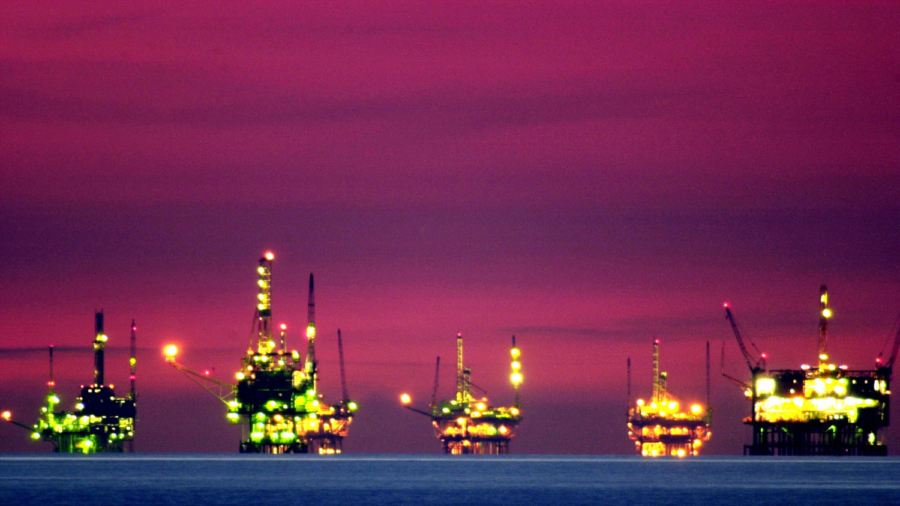Policies prohibiting any new offshore oil drilling and affiliated infrastructure construction within California state waters were adopted as Gov. Jerry Brown signed two bills on Sept. 8, which symbolize an effort against the recent oil drilling expansion plan proposed by the federal government.
SB 834 requires that the State Lands Commision and a local trustee will not enter into any new lease, lease renewal, or extension, as well as modification if it involves new construction of oil-and-gas-related infrastructure within states waters and is related to Outer Continental Shelf (OCS) leases issued after Jan. 1, 2018. And AB 1775 prohibits any new lease, lease renewal, extension, or modification in the Sanctuary that leads to an increase of oil or natural gas production from federal waters.

According to the law, state waters are defined as areas starting from the state’s coastline and extend 3 miles toward the ocean, while federal waters are areas beyond that 3-mile boundary. Since the bills prohibit new leases within state waters for new construction of oil- and gas-related infrastructure, such as pipelines, which is the most common method to transport crude oil, supporters of the bills believe it will make it more difficult for the federal government to implement new offshore oil drilling along the California coast.
Currently, there are 38 active leases in the Pacific OCS Region and all of them are along the California coast. And there has been no new lease in federal waters since 1984. In January, U.S. Secretary of the Interior Ryan Zinke announced a draft National OCS Program that makes over 90 percent of the total OCS acreage available for future exploration and development. Proposing the largest number of lease sales in U.S. history, the program has a total of 47 potential leases including six leases off California coast.
“By proposing to open up nearly the entire OCS for potential oil and gas exploration, the United States can advance the goal of moving from aspiring for energy independence to attaining energy dominance,” Counselor for Energy Policy at Interior Vincent DeVito said in a statement. “This decision could bring unprecedented access to America’s extensive offshore oil and gas resources and allows us to better compete with other oil-rich nations.”
In 2016, California ranked No. 3 in crude oil production with annual production of around 186 million barrels. But oil produced from California offshore drilling only accounts for less than 10 percent with around 11.5 million barrels from state waters plus 6.1 million barrels from federal waters. According to the California State Lands Commission, California has total 27 offshore oil platforms, among which only four are located within state waters and 23 within federal waters.
The California State Lands Commission (SLC) was granted jurisdiction to oversee and manage the leasing of oil and gas from offshore state lands in 1938. And no new offshore oil and gas leases have been approved by SLC since 1969—the year a major offshore oil spill happened near Santa Barbara. The incident was caused by an inadequate protective wellpipe casing, which led to more than 80,000 barrels of crude oil released into the ocean resulting in 35 miles of coastline oiled and killed thousands of animals. Worrying about potential environmental impacts and consequences of new drilling, many California lawmakers oppose the federal government’s expansion plan.

“Additional offshore oil and gas development in California poses a serious risk of oil spills, jeopardizing our air and water quality, as well as our marine resources and wildlife, including threatened species,” said Sen. Hannah Beth Jackson (D-19th District), who authored SB 834. “Expanded offshore oil and gas production also directly threatens the health of California’s ocean-based economy, which produces approximately $44.5 billion in GDP each year, and employs almost half a million people in the state.”
In addition, even though California has made many efforts in shifting from traditional fossil fuels to renewable energy, the demand for crude oil has hardly been reduced over the last decade. Based on statistics showed by the California Energy Commission, in 2009, 605 million barrels of crude oil were supplied to California refineries with nearly 40 percent from California itself and 45 percent from foreign countries. In 2017, the total crude oil supply grew to about 625 million barrels with around 31 percent from California and 57 percent from foreign countries.
From The Epoch Times


